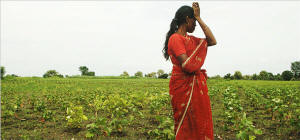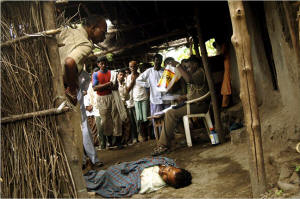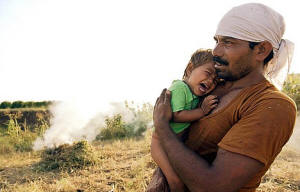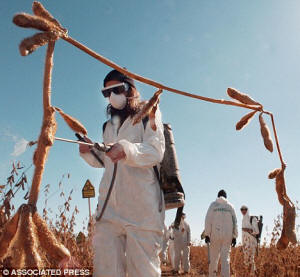by Anne Sewell
Mar 28, 2012
NOTICE: THIS WORK MAY BE PROTECTED BY COPYRIGHT
YOU ARE REQUIRED TO READ THE COPYRIGHT NOTICE AT THIS LINK BEFORE YOU READ THE FOLLOWING WORK, THAT IS AVAILABLE SOLELY FOR PRIVATE STUDY, SCHOLARSHIP OR RESEARCH PURSUANT TO 17 U.S.C. SECTION 107 AND 108. IN THE EVENT THAT THE LIBRARY DETERMINES THAT UNLAWFUL COPYING OF THIS WORK HAS OCCURRED, THE LIBRARY HAS THE RIGHT TO BLOCK THE I.P. ADDRESS AT WHICH THE UNLAWFUL COPYING APPEARED TO HAVE OCCURRED. THANK YOU FOR RESPECTING THE RIGHTS OF COPYRIGHT OWNERS.
Bt cotton hybrids are pointing to drastic depletion of soil nutrients due to repeated cultivation. Crop failures and less yield from the use of transgenic seeds are causing suicides among Indian farmers.

Cotton bolls ready for harvest
Crop Yields
The Coalition for GM-Free India has issued a new report. It has been 10 years since Bt (Bacillus thuringiensis) cotton was officially introduced to India, and while promoters and manufacturers want the world to believe that it is an unqualified success, the reality is very different. The Coalition consists of a large network of scientists, farmer unions, consumer groups and organizations.
Farmers in India were promised miraculous crop yields using Bt cotton.

Spores and crystals of Bacillus thuringiensis serovar morrisoni strain.
Jim Buckman
The Hindu reports that the hype over Bt cotton is typified by recent advertisements by Mahyco-Monsanto claiming “Bollgard boosts Indian cotton farmers' income by over Rs.31,500 crores.” However, the Advertising Standards Council of India states that this is false information.
The report by the Coalition for GM-Free India stresses the deep crisis in cotton farming after 10 years of using transgenic seeds. In the period 2011-12, the spate of farmer suicides has been largely among Bt cotton farmers. Not only do the farmers suffer when crops fail, but they cannot afford to buy seeds for each crop.
According to state government estimates in December 2011, during the Kharif 2011 season in Andhra Pradesh, of 47 lakh acres planted with Bt cotton, 33.73 lakh acres suffered from crop failure. In other words, two-thirds of the cotton area had a yield loss of more than 50%.
In the Maharashtra area, poor performance of the cotton crop has led to a significant lowering of production estimates despite the increase in cotton cultivation in the area.
The crisis in cotton cultivation last year caused the Maharashta government to announce a bailout for cotton, paddy and soyabean crops of Rs 2000 crores.
Bt cotton was approved in 2002, but the initial adoption of the crop was slow. By 2004-05 only 5.6% of cultivated cotton was Bt. Data from the Central Institute of Cotton Research (CICR) shows increasing areas under Bt cotton and decreasing yields.
Comparing the periods 2005-06 to 2011-12, a different story emerges.
In the pre-Bt cotton era, due to non-Bt hybrid seed and other facts, yields were already rising sharply. In the next 5 year period, the yield increased by 69%.
From 2005-06, utilizing Bt cotton, a moderate 17% increase was achieved up to 2007-08. (554 kg/ha compared to 470 kg/ha). Since then the yields show a downward trend.
Now in the period 2011/12, cotton yields have reached the pre-Bt levels of 480 kg/ha compared to 470 kg/ha, which is only an initial estimate by the Cotton Advisory Board. The report says that the actual number is likely to be lower than that.
Dr Kranthi's paper which reviews 10 years of Bt cotton corroborates this downward trend:
“The main issue that worries stakeholders is the stagnation of productivity at an average of 500 kg lint per ha for the past seven years. The gains have been stagnant and unaffected by the increase in area of Bt cotton from 5.6 per cent in 2004 to 85 per cent in 2010. The yield was 463 kg per hectare when the Bt cotton area was 5.6 per cent in 2004 and reached a mere 506 kg per hectare when the area under Bt cotton increased to 9.4 million hectares at 85 per cent of the total 11.1 million hectares.”
Dr Kranthi's report supplies numbers which show “progressive problems and stagnation of production and productivity.”
The paper stresses the use of irrigation facilities to bring new farmlands under Bt cotton, well distributed rainfall and low pest activity. The shift towards hybrid cotton and pesticides with novel modes of action are important in helping cotton productivity, not just the introduction of the Bt gene.
According to his report, Dr Kranthia says that due to repeated cultivation of Bt cotton hybrids, there has been a severe depletion of nutrients in the soil. The Bt crops draw more water and nutrients from the soil and now are exhibiting nutrient deficiency. In the rain-fed zones, crops are suffering from leaf-reddening and wilt problems, which are getting more severe as years go by.
In spite of the extensive government data and the report by Dr Kranthia, Union agriculture minister Sharad Pawar has praised Bt cotton in Parliament. He says that the high quality hybrid cotton seeds had helped farmers "make big gains due to reduced use of pesticides."
The truth of the situation seems to be rather different.
Farmers protests marked 10th anniversary
On the 10th anniversary of the introduction of genetically modified (GM) Bt cotton to India, angry farmers protested and urged parliamentarians to hold a special session. They implored parliamentarians to discuss the issue of Bt cotton and to ban the technology in India.
A few seed companies, particularly agro-giant Monsanto, are monopolizing the seed industry in India. The social activists say that these companies are "setting the agenda" for the government and that the government should "reject the hype" around Bt cotton and demand a more comprehensive review of the product. “The crisis in the cotton belt should be closely examined and critically re-assessed,” they said.
Protests were lead by the Delhi Alliance for Safe Food in Jantar Mantar and similar protests arose in the cotton areas of Madhya Pradesh, Andhra Pradesh, Karnataka and Maharashtra.
The Bt cotton technology was intended for irrigated areas, but was pushed on all cotton-growing states including the rain-fed areas. This caused a higher rate of suicides in cotton growers, especially in Maharashta, due to crop failures.
Because of the high suicide rate in this state, protests were more intense -- farmers burned Bt cotton crops in many villages, according to the Vidarbha Jan Andolan Samiti. The protests included several wives of farmers who had committed suicide.
Kishor Tiwari of the Andolan stated: “Ten years ago, permission was granted to U.S. based Monsanto seed giant for experimental cultivation of [bollworm-resistant] GM Bt cotton in 10,000 hectares in different parts of the country. Today, with the push given to it, the acreage has gone up to over 12 million hectares and [the crop is] sown by 90 per cent growers, especially after Maharashtra permitted commercial cultivation trials of Bt cotton from June 2005.”
Referring to the report of the Coalition for GM-free India mentioned above, which proves that Bt cotton has resulted in the evolution of new pests and diseases and stagnant yields, activists said: “Yet, its use has spread because the creditors in the informal sector, who double up as seed agents, promote the Bt seed and deprive farmers of the traditional variety.”
The protesters and activists have demanded that the Indian government returns to the production of conventional cotton seeds. They say that the government should also advise farmers about the risks of planting Bt cotton. They demand that there should be a strict action against misleading advertising and false claims by the seed companies, including Monsanto.





